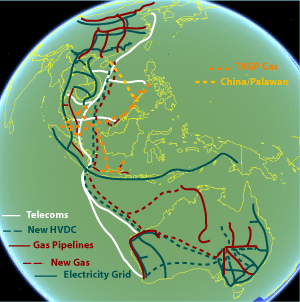 Why not an Asia-Pacific partnership based upon energy?Mar 9, 2009 -Stewart Taggart - DESERTEC The European Union began in the 1950s as a common market for coal. In the 21st Century, Australia and Asia could forge a similar common market for solar, geothermal, wind and wave energy. Doing so would spur hemispheric integration. It would boost economic growth, enhance regional geopolitical cooperation and help combat global climate change. The Asia-Pacific Partnership could be the vehicle. This moribund pet project of Prime Minister Kevin Rudd to date has focused only on vague ideas of increased regional cooperation. Why not 'beef it up' by declaring the Asia-Pacific Partnership an 'energy for peace' project? Doing so would build on regional strengths, including:
An integrated Asian hemisphere energy system would encourage cross-border trading in low emission energy. Over time, cross-border price transparency would allow the market to solve climate change by choosing the best technologies with the lowest prices and lowest emissions. The plan would involve connecting Australia to Southeast Asia and China with UHVDC power lines. If pan-regional natural gas pipelines were built at the same time, construction costs of both would be reduced. Ultimately, a pan-Asian energy system would bind regional economies closer together. This would lessen the potential for geopolitical conflict, particularly over energy. The next few years are critical. Despite the global financial crisis, huge new global expenditure on upgrading utility grids and expanding power production is unavoidable. The existing energy infrastructure is old and is crumbling under the rising demands of 21st Century economies. Once climate change is tossed in, the argument for such investment becomes unassailable.
How might it work? By inter-connecting Asia's highly-fragmented electricity grids and natural gas pipeline systems. The regional fiber optic cable system can be used to provide pathways. Such an pan-Asian infrastructure would mesh together projects already under way, or on the drawing boards in the region. A pan-Asian infrastructure is a common-sense, incremental extension of existing and planned regional infrastructure projects, not a revolutionary new idea. In the 17th Century, English economist David Ricardo developed the economic concept of 'comparative advantage.' Comparative advantage means countries should do what they do best, and use their selective excellence as a medium of exchange for other countries' products. Asia is full of comparative advantage in energy. China has expertise in Ultra High Voltage Direct Current power lines. Cambodia and Laos have hydro power. Vietnam has hydro and wind. Malaysia has biomass and offshore wind. The Philippines and Indonesia both have wind and geothermal. And Australia, of course, has it all: sun, wind, geothermal, wave, tides and biomass. Put it all together and what emerges is a fledgling 'common market' in energy. Solving climate change lies in powering global society with the lowest-cost, lowest-emission energy possible. Developing a competitive, cross-border market in energy, the lowest-cost, lowest-emission energy will emerge by default. In a recent report, the US investment house Merrill Lynch outlined the five technological revolutions that have occurred since the 1700s. It posited that the world is now embarking upon a sixth: Cleantech. Looking at the list, it's clear a pan-Asian energy freeway marked by an open market in energy would give Asia a significant position in each of the 21st Century's wealth generating sunrise industries. A better vision for Kevin Rudd's Asia Pacific Partnership is hard to imagine. Stewart Taggart is a director of Acquasol Infrastructure Ltd., a developer of environmentally-friendly power and water solutions building a municipal-scale solar desalination plant in South Australia's Upper Spencer Gulf. Stewart is also founder/administrator of DESERTEC-Australia, DESERTEC-USA and DESERTEC-China. DESERTEC promotes the concept of "Clean Power From Deserts." Additional Reading: Asia Pacific Community: Nuclear: DESERTEC-Australia has developed roadmaps
for how Australia's individual states can contribute
to the retooling of Australia's and Asia's energy
economy: Editor's Note: This opinion was provided by DESERTEC-Australia, please click here to sign up to their mailing list. This article is under copyright; permission must be sought from DESERTEC-Australia in order to reproduce it.
|
Email this page to a friend
If you speak another language fluently and you liked this page, make
a contribution by translating
it! For additional translations check out FreeTranslation.com
(Voor vertaling van Engels tot Nederlands)
(For oversettelse fra Engelsk til Norsk)
(Для дополнительных
переводов проверяют
FreeTranslation.com )


